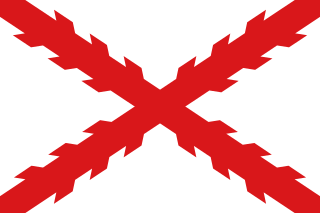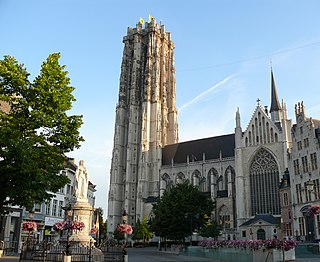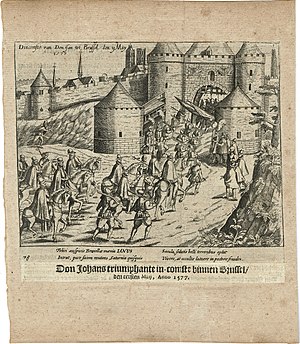
Transport in Belgium is facilitated with well-developed road, air, rail and water networks. The rail network has 2,950 km (1,830 mi) of electrified tracks. There are 118,414 km (73,579 mi) of roads, among which there are 1,747 km (1,086 mi) of motorways, 13,892 km (8,632 mi) of main roads and 102,775 km (63,861 mi) of other paved roads. There is also a well-developed urban rail network in Brussels, Antwerp, Ghent and Charleroi. The ports of Antwerp and Bruges-Zeebrugge are two of the biggest seaports in Europe. Brussels Airport is Belgium's biggest airport.

Flanders is the Dutch-speaking northern portion of Belgium and one of the communities, regions and language areas of Belgium. However, there are several overlapping definitions, including ones related to culture, language, politics, and history, and sometimes involving neighbouring countries. The demonym associated with Flanders is Fleming, while the corresponding adjective is Flemish, which can also refer to the collective of Dutch dialects spoken in that area, or more generally the Belgian variant of Standard Dutch. The official capital of Flanders is the City of Brussels, although the Brussels-Capital Region that includes it has an independent regional government. The powers of the government of Flanders consist, among others, of economic affairs in the Flemish Region and the community aspects of Flanders life in Brussels, such as Flemish culture and education.

The Seventeen Provinces were the Imperial states of the Habsburg Netherlands in the 16th century. They roughly covered the Low Countries, i.e., what is now the Netherlands, Belgium, Luxembourg, and most of the French departments of Nord and Pas-de-Calais (Artois). Also within this area were semi-independent fiefdoms, mainly ecclesiastical ones, such as Liège, Cambrai and Stavelot-Malmedy.

The Duke of Brabant was the ruler of the Duchy of Brabant since 1183/1184. The title was created by the Holy Roman Emperor Frederick Barbarossa in favor of Henry I of the House of Reginar, son of Godfrey III of Leuven. The Duchy of Brabant was a feudal elevation of the existing title of landgrave of Brabant. This was an Imperial fief which was assigned to Count Henry III of Leuven shortly after the death of the preceding count of Brabant, Herman II of Lotharingia. Although the corresponding county was quite small its name was applied to the entire country under control of the dukes from the 13th century on. In 1190, after the death of Godfrey III, Henry I also became duke of Lotharingia. Formerly Lower Lotharingia, this title was now practically without territorial authority, but was borne by the later dukes of Brabant as an honorific title.

The Spanish Netherlands was the Habsburg Netherlands ruled by the Spanish branch of the Habsburgs from 1556 to 1714. They were a collection of States of the Holy Roman Empire in the Low Countries held in personal union by the Spanish Crown. This region comprised most of the modern states of Belgium and Luxembourg, as well as parts of northern France, the southern Netherlands, and western Germany, with the capital being Brussels. The Army of Flanders was given the task of defending the territory.

The Duchy of Brabant, a state of the Holy Roman Empire, was established in 1183. It developed from the Landgraviate of Brabant of 1085–1183, and formed the heart of the historic Low Countries. The Duchy comprised part of the Burgundian Netherlands from 1430 and of the Habsburg Netherlands from 1482, until it was partitioned after the Dutch revolt of 1566–1648.

Habsburg Netherlands was the Renaissance period fiefs in the Low Countries held by the Holy Roman Empire's House of Habsburg. The rule began in 1482, when the last Valois-Burgundy ruler of the Netherlands, Mary, wife of Maximilian I of Austria, died. Their grandson, Emperor Charles V, was born in the Habsburg Netherlands and made Brussels one of his capitals.

Brussels Airport-Zaventem railway station is a railway station located beneath Brussels Airport in Zaventem, Flemish Brabant, Belgium. The station opened in 1958 on railway line 36C; in 2012, the new line 25N was added. It was formerly called Brussels-National-Airport railway station until April 2016. The train services are operated by the National Railway Company of Belgium (NMBS/SNCB).

The Joyous Entry of 1356 is the charter of liberties granted to the burghers of the Duchy of Brabant by the newly-ascended Duchess Joanna and her husband Duke Wenceslaus. The document is dated 3 January 1356, (NS) and it is seen as the equivalent of Magna Carta for the Low Countries.

The following is a timeline of the history of Brussels, Belgium.
The following is a timeline of the history of the municipality of Antwerp, Belgium.
Events from the 1580s in the Spanish Netherlands and Prince-bishopric of Liège.

The Archdiocese of Mechelen–Brussels is a Latin Church ecclesiastical territory or archdiocese of the Catholic Church in Belgium. It is the primatial see of Belgium and the centre of the ecclesiastical province governed by the Archbishop of Mechelen–Brussels, which covers the whole of Belgium. It was formed in 1559 and the bishop has a seat in two cathedrals, St. Rumbold's Cathedral in Mechelen and the Cathedral of St. Michael and St. Gudula in Brussels. The current archbishop is Luc Terlinden, who was installed in September 2023.
Léon-Jean de Paepe (1610–1685), lord of Glabbeek, was an officeholder and statesman in the Spanish Netherlands. After serving on the Council of Brabant in Brussels and on the Supreme Council of Flanders in Madrid, De Paepe was appointed president of the Privy Council of the Habsburg Netherlands in 1674. He died on 8 August 1685.
Events in the year 1634 in the Spanish Netherlands and Prince-bishopric of Liège.
Events in the year 1635 in the Spanish Netherlands and Prince-bishopric of Liège.

The Burgundian State is a concept coined by historians to describe the vast complex of territories that is also referred to as Valois Burgundy.












